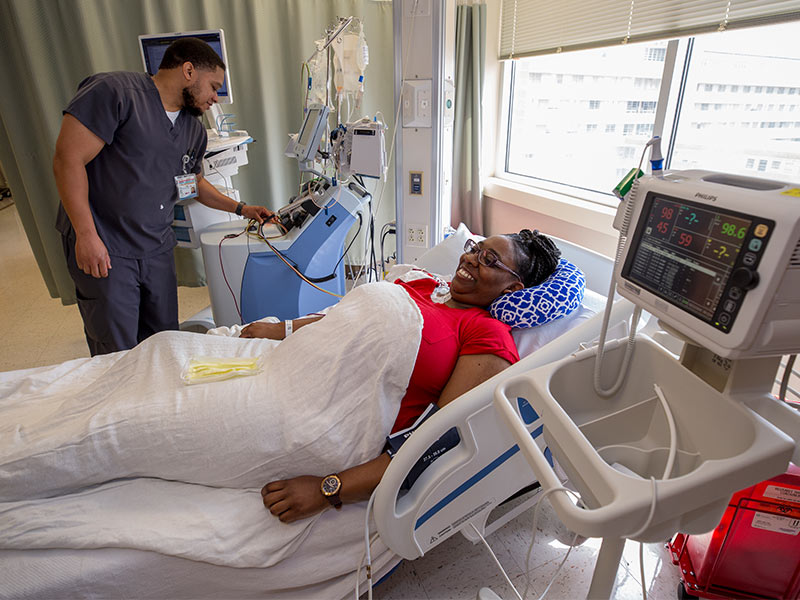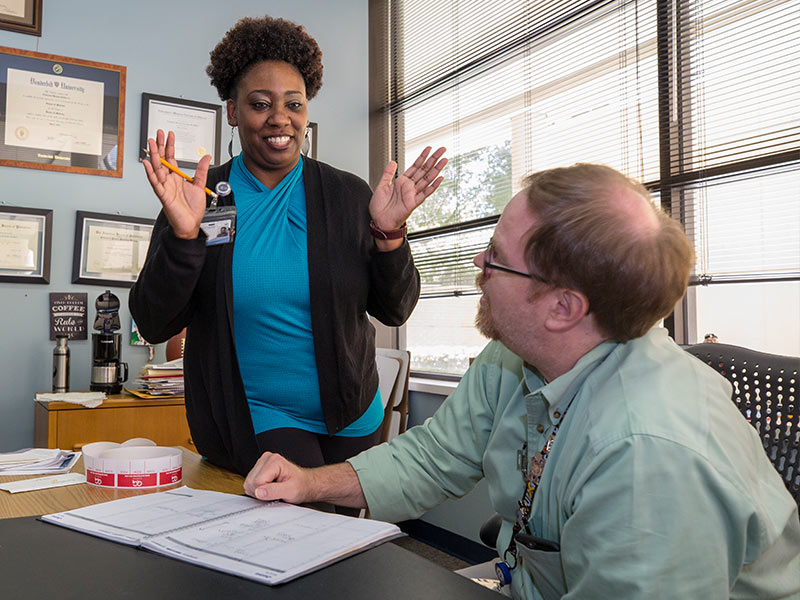UMMC employee donates stem cells to perhaps save a life

For nine years Jessica Dobbins waited for the call. This year, she got it.
Dobbins was so determined to help someone who needed a stem cell or bone marrow transplant that she signed up on two registries.
Both called, but for the same patient. By the end of May, Dobbins, an administrative assistant in the University of Mississippi Medical Center’s Division of Pediatric Hematology and Oncology, had completed tissue typing and donated stem cells.
“I signed up because there are not a lot of African-Americans and people of color in the system,” said Dobbins. “I used to work in administration at the hospital and admitted some BMT patients. Now everything is coming full circle. I’m donating and the stem cells are being removed on the BMT unit to which I once helped admit patients.”
When she donated, she worked in the UMMC Cancer Institute’s Children’s Cancer Center, whose patients sometimes receive stem cell or bone marrow transplants. In June she moves to another pediatric unit, leaving a bit of her heart with CCC.
“When I heard that Jessica was going to be a donor, I was so proud of her for not only being willing, but also because she was so excited to do it,” said Dr. Anderson Collier, associate professor and director of the Division of Pediatric Hematology and Oncology.
“I see the recipient side of things most of the time. I rarely get to see the donor side. It was encouraging to me to see her excitement,” he said.

“I had hoped to be called for a pediatric patient. I wanted to give them a chance to live,” Dobbins said.
She matched to an adult male. “Now I’m hoping that when he receives my stem cells, he gets cured,” she said.
Mattie Coburn, donor recruiter with the Division of Hematology and Oncology, said Dobbins followed a procedure many others follow to donate.
Those steps include:
- Donors sign up for a registry. Be the Match, a part of the National Marrow Donor Program, collects swabs taken from the cheeks of possible donors, tissue types them and keeps those records on file. When doctors cannot find a match among family members, they call the registry.
- Once the Registry has an initial match, as in Dobbins' case, they’ll ask the donor to undergo a physical exam and more testing to determine they’re healthy enough to donate.
- Patients usually get shots, starting four days before their stem cells are harvested. “Most cells concentrate in the bone marrow. We want those cells flowing in the peripheral blood. We give the donor a stimulant called filgrastim, to break up those cells and get them flowing,” Coburn said. Side effects, usually mild, might include muscle or body aches, dull headaches, and fatigue.
- On the fifth day, patients receive the final shot and donate stem cells through a process called apheresis. Dobbins’ blood was withdrawn, passed through a machine that separates the white blood cells, and returns the rest to her body. Most donors have blood withdrawn from one arm and returned in another. Dobbins had such small veins she elected to have a central line placement. The apheresis process usually takes four to five hours.
- The recipient’s physician will decide if they need stem cells or bone marrow. In a bone marrow donation the patient will have to undergo a procedure in which some marrow is removed from their hip. That may require a short hospital stay.
- The stem cells or bone marrow are prepared for travel and taken by courier to the recipient’s hospital. That could be anywhere in the world.
- After a year, if the donor and recipient wish, they can make contact. Until then, all communication is handled through the registry.

Dobbins said she experienced some side effects, body aches and fatigue, but not enough to prevent her from working in the days preceding her donation.
And, although unlikely, she said she’d donate again if needed.
“I see kids whose lives are saved by bone marrow transplant. Anyone who has a chance to live longer, I want to help, even if it’s not my family,” she said. “People need to at least be swabbed for it, especially people of color.”
Collier agrees. “It is harder to find a donor for African American patients,” he said. “The majority of the donors are Caucasian. When an African American patient needs a transplant the options are more limited.”
Stem cell or bone marrow transplants are used for cancers, but also for sickle cell disease, and some types of bone marrow failure. “Bone marrow transplant is currently the only cure for sickle cell disease, but its utility is limited due in part to lack of suitable donors,” Collier said.
For about 25 years, UMMC has operated the state’s only bone marrow transplant unit where patients receive transplants and donors give marrow or stem cells.
Collier said this one is special for himself and his co-workers: “We could not be more proud that someone who works in a hospital, in a division that does bone marrow transplants, gets to be a donor. She gets to share in hopefully, a cure for some patient we do not even know.”
Join the Be the Match Registry or learn more about it here. https://bethematch.org/support-the-cause/donate-bone-marrow/join-the-marrow-registry/


